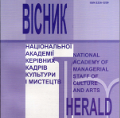ІНВАРІАНТИ ОРГАНІЗАЦІЙНО-ЕКОНОМІЧНОЇ БІЗНЕС-МОДЕЛІ ОПЕРНОЇ СЦЕНИ: ІСТОРИЧНИЙ ДИСКУРС
INVARIANTS OF THE ORGANISATIONAL-ECONOMIC BUSINESS MODEL OF OPERA STAGE: HISTORICAL DISCOURSE
Author(s): Kateryna Volodymyrivna Iudova-Romanova, Ihor Borko, Iryna SemenenkoSubject(s): Theatre, Dance, Performing Arts, Music, History of Art
Published by: Національна академія керівних кадрів культури і мистецтв
Keywords: opera art of Italy; business model; theatre history; theatre industry; audience; stage design;
Summary/Abstract: The purpose of the article is to analyse and systematise various organisational-economic business models of opera production in 17th century Italy as an artistic form and business in a historical context. Research methodology. To achieve the stated objective, the following scientific approaches were applied: historical –understand the context and evolution of opera business models; comparative – to identify commonalities and differences between them; socio-economic analysis – to assess financial aspects, including production costs; case study – to study the business models of specific opera houses and productions to argue general trends and identify invariants. Scientific novelty. This study conducts a comprehensive analysis and systematisation of various organisational-economic business models of opera production in 17th century Italy for the first time, allowing for a better understanding of how different economic and social contexts influenced the development of opera as both art and business. Conclusions. Based on the analysis of the collected and systematised facts from the history of the 17th century Italian opera scene, the main principles and features of the three leading organisational-economic business models of opera production of this period were formulated. The Roman business model was based on patronage, where very expensive productions were financed by patrons and were free for the audience, emphasising the cultural, social, and political prestige of the patrons. The Venetian business model was entrepreneurial, where the impresario played the key role as the event organiser. Although this approach was market-driven, it also required patron support and quite risky investments to finance the opera company. The Reggio Emilia business model represents a mixed approach, where an influential patron played a significant role in providing financial support and covering potential losses.
Journal: Вісник Національної академії керівних кадрів культури і мистецтв
- Issue Year: 2024
- Issue No: 2
- Page Range: 384-391
- Page Count: 8
- Language: Ukrainian

